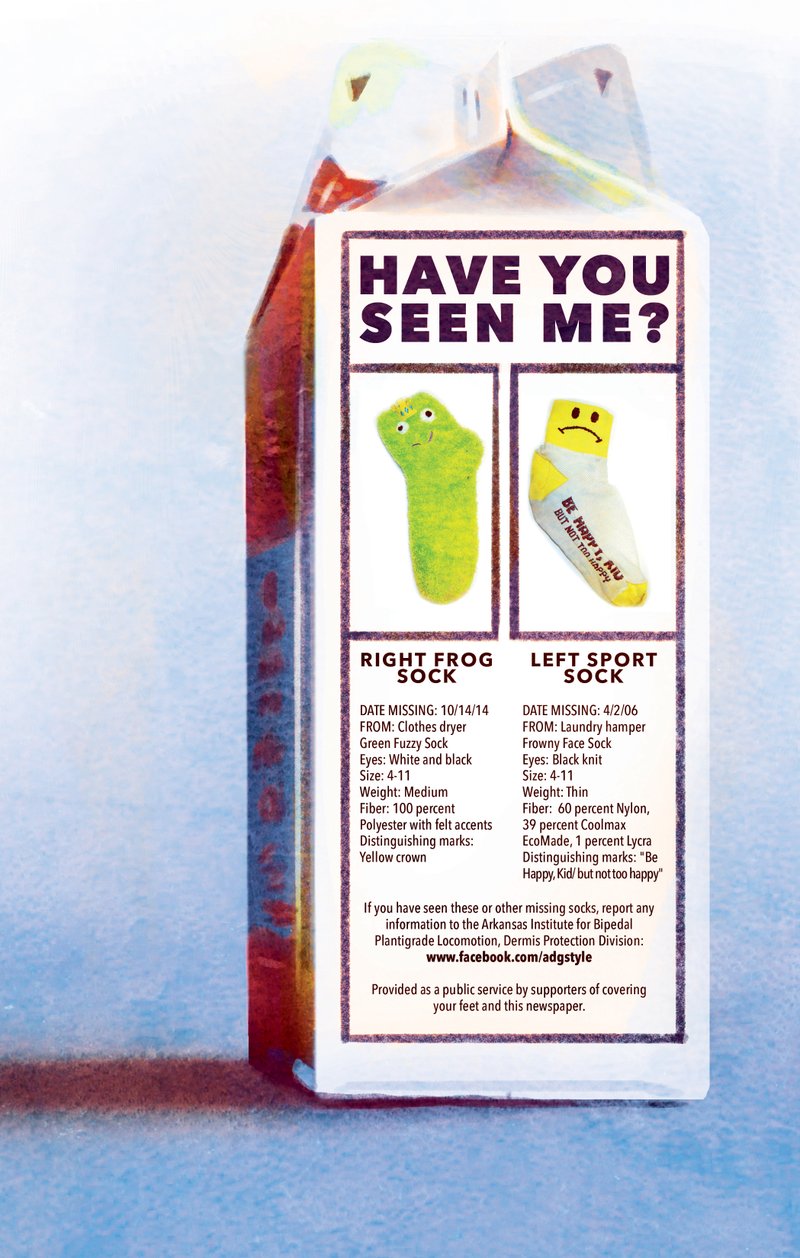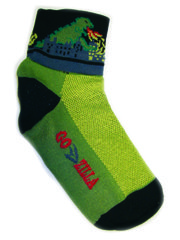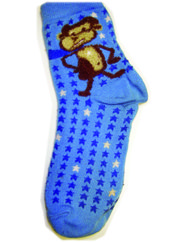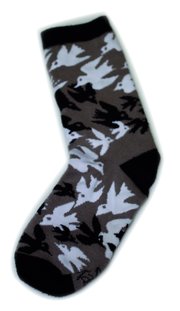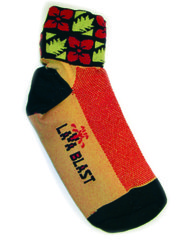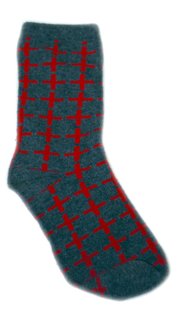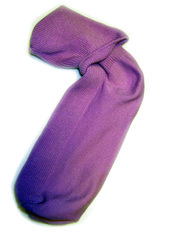Socks may be, next to unmentionables, the ultimate in sartorial practicality. Often obscured by other clothing, they keep feet warm, keep shoes from being sweaty.
This might be why they have traditionally been seen as the ultimate bummer gift. But if you received a pair or two of well-made, creative, fun-and-funky socks for Christmas, there's a good chance you weren't so disappointed.
Whether they're made by Gold Toe, Farm to Feet, Nike or Hanes; whether they're the conventional design or made with individual toes, socks have become "a thing."
From a fashion standpoint, the designs found on socks are jaw-droppers. Items that not so long ago came only in basic white styles, businesslike solids or noticeable but still conservative argyle patterns have developed more dramatic personalities. Take a look at just one sock website, and you'll be greeted by pattern options as diverse as animals, Rosie the Riveter, doughnuts, art reproductions and holiday symbols.
Want a quick way to jazz up a conservative suit or outfit? Catch a pair of wild socks.
SOCK HOP
The proof of socks' increasing rock-star status was noted about a year ago by the NPD Group, a market research company.
"The garment historically worn for warmth and protection is making a move from commodity to fashion piece, with growth ... morphing it into a $5.6 billion industry as of the 12 months ending August 2014," according to the group's late 2014 report.
The report reveals that 73 percent of men wear socks daily, while 41 percent of women do. On average, men outspend women for socks.
"Socks are the new power ties," according to another 2014 NPD report. Small wonder that sock subscription services, or sock-of-the-month clubs, can be found all over cyberspace.
There's a sock to fit just about any lifestyle. Sock fabric choices and combinations are just as myriad. Cotton. Wool. Bamboo. Silk. Nylon. Polyester. Lycra.
"One thing people always want to know is what's better -- cotton, wool or synthetic socks," says Dr. Robert Martin, a foot and ankle surgeon at the University of Arkansas for Medical Sciences and assistant professor of orthopedic surgery at the UAMS College of Medicine. All of those are good, he says. It just depends on what kind of activity you're doing.
"I think cotton socks are nice because they're oftentimes padded, and they're often absorbent, just like a towel is," he says. "If you have sweaty feet, the cotton socks will help get the moisture off of your feet.
"The drawback to them is that they don't breathe and wick moisture away, so if you keep them on for a long period of time, the socks can basically become saturated with moisture."
They also don't provide the padding of, say, wool socks -- which Martin sees as offering the best advantages of cotton along with the best of synthetic fibers. They're cushioned and somewhat absorbent, but also pull moisture away from the skin and dry quickly. They provide insulation even while wet.
"The synthetic socks that athletes and runners most frequently wear are excellent for wicking and pulling moisture away from the foot and also have a significant amount of padding as well."
But, Martin adds, they "maybe aren't quite as absorbent as the cotton sock."
Prices for socks run the gamut. Cotton socks tend to be cheaper. On the highest end are wool or synthetic blends. It's not uncommon to find running socks priced at $15 a pair. Are these "technical fibers" worth it?
"If they're comfortable and they feel better to you than any other socks, then I think it's worth it," Martin says.
SOCK HEALERS
And if they keep you healthy where other socks might not, they're definitely worth paying for.
Such is the the case with compression socks, for which prescriptions can be written and which insurance will cover in some cases. Martin says the UAMS Orthopedic Clinic carries such socks and gives them out to patients.
"Usually compression socks are for those who have chronic edema or acute edema," Martin says. This includes swelling after surgery, cases of lymphedema (swelling caused by lymphatic-system blockage) and chronic swelling in the lower extremities. Compression socks can speed up recovery time, forcing the swelling to decrease in a shorter amount of time than if the area was left untreated.
People with diabetes, deep-vein thrombosis and varicose veins -- or those at risk of these circulation-related conditions -- are common users, according to webmd.com.
For decades, healthy people might select compression socks if their jobs kept them on their feet all day. Lately, manufacturers of sporting apparel are pushing compression socks for people involved in athletics and exercise. (The efficacy of that compression for performance, injury prevention or recovery from exercise is an unsettled area of science.)
INFORMED DONATION
With so many socks on the market, the inexpensive, basic white, cotton-blend sock has faded into the background. But it has its fans. Especially among those on the streets.
"[The] best socks for homeless are white crew or tube socks in a cotton blend," says Sandra Wilson, former head of the Arkansas Homeless Coalition and a longtime advocate for helping street people in Little Rock. "Some people are allergic to dyes, but never to white."
When making donations, she'll give black socks to the working homeless people, "but white for the masses."
Wilson adds that she prefers to give crew-style socks because both men and women are happy with them.
SOCK LIMBO
One of the most frustrating things about socks -- and increasingly expensive as consumers invest in ever fancier and more "technical" socks -- is that, like all too many human marriages, sock pairings often are not permanent.
Pairs of socks become singles.
And that's usually because one mate fails to return from a trip to the laundry.
Where do they go?
"The theory was that sometimes they can get sucked up in the dryer [filter] ... sometimes when you clean it out, you'll find your socks back there," says Crystal Rotich of North Little Rock, owner of the Little Rock branch of Laundry Care LLC.
Rotich, who offers free delivery and pickup for individuals and small businesses such as salons and chiropractors' offices, has a simple way to keep up with her clients' socks: a delicates bag, which she also uses to wash undergarments.
"That's sort of our solution to keep [socks] from getting lost. I have come up with that [solution] with my own personal laundry since I have a young son. His little socks tend to go ... places."
And then there's the magnet solution ... advocated by Catenya McHenry, owner of SoleMate Sox (Solematesox.com).
SoleMate Sox was born out of McHenry's frustration over losing her children's socks in the laundry. The Tuscaloosa, Ala., mother of three bypassed the clothespin/safety-pin methods of keeping socks together in the laundry and came up with embedding magnets in the bands of socks.
A pair of socks can be joined magnetically, she says, and the laundry will not pluck them asunder. These are funky, vividly patterned socks for men and women, designed by McHenry's children and costing $28.50 a pair. (The patent-pending socks are made in Fort Payne, Ala., which once billed itself as the world's sock capital, with more than 100 sock mills. Thanks to overseas production, the city now has only a dozen mills.)
"I have a basket of laundry right now that has ... about a dozen or so missing socks," McHenry lamented.
"I try so hard to stay organized ... I try to teach the children how to keep their stuff together when they put it in the laundry basket. ... Nothing has helped -- nothing. I still end up with a basket of missing mates."
After a year and a half in development, SoleMate Sox debuted Dec. 14. "The very first day was phenomenal," McHenry says. "We were getting orders up until 11, 12 o'clock that night ... the sales continued that entire week."
SOLE CLEANSING
Keeping socks present and accounted for isn't the only challenge sock lovers face, especially owners of white or light-colored socks.
"People wear them a lot and sometimes you get those that wear them [without shoes] in the house," Rotich says. "Sometimes they can be difficult to clean."
Her solution: Soak the dirt with Clorox Color for five minutes. "It actually does really well."
ActiveStyle on 01/04/2016
